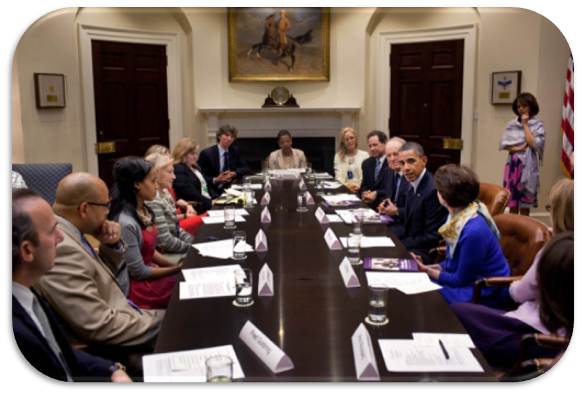
President’s Committee on the Arts and the Humanities explores the state of arts education
By Jonathan Lewis, President’s Committee on the Arts and the Humanities
On May 6th, 2011, before a packed room in the Hotel Palomar in Washington D.C., members from the President’s Committee on the Arts and the Humanities unveiled an ambitious new study on Arts Education in the United States. The report, Re-Investing in Arts Education: Winning America’s Future Through Creative Schools is the result of 18 months of extensive interviews and research, and was accomplished with major support from the John S. and James L. Knight Foundation. Several public figures spoke about the report’s exciting findings, including Melody Barnes, Director, White House Domestic Policy Council; Margo Lion, Broadway Producer; Kaya Henderson, Chancellor, DC Public Schools; Ted Leonsis, Washington Capitals and Wizards owner; and Mary Schmidt Campbell, Dean, Tisch School of the Arts, NYU.
The report, which includes a foreward by U.S. Secretary of Education Arne Duncan, takes into account major shifts in the landscape of American education over the past decade, as well as recent longitudinal studies and new findings in neuroscience. The result is some of the most robust data to date showing that an arts education greatly increases academic performance and creativity, especially for low-income students. The report makes the following points:
- Early exposure to the arts helps students to develop the critical thinking skills that will help them to excel in the jobs of tomorrow. Business leaders are recognizing that in order to compete in the global economy, our workforce has to be innovative. An arts education helps students learn to think outside the box, and to approach challenges with creative solutions. This is why the leaders and entrepreneurs of today’s most successful companies – everyone from Apple founder and CEO, Steve Jobs, to Groupon founder and CEO, Andrew Mason –credit their success to having had an arts education.
- Arts Education requires different approaches and collaborations. After visiting schools across the country that offer arts education programs, the Committee found that the most successful programs involve a mix of classroom teachers, arts specialists, teaching artists, and arts integration programs. No single solution works for all schools, but an overall focus on the quality of arts education as well as promoting flexibility and collaboration, results in some of the most successful programs.
- Develop the field of arts integration. Arts integration involves classroom teachers incorporating the arts into the teaching of other subjects – such as math, science, social studies, and reading – and vice versa. This is usually done in collaboration with arts specialists and/or teaching artists. The results are extraordinary: increases in student attendance; higher test scores; higher school morale; and a rewarding and enriching experience for all parties involved, from students, to teachers, parents, to school administrators.
The Committee intends this report as a practical tool for school administrators, state and district decision-makers, business leaders, and the public—as they weigh priorities in their school budgets. The President’s Committee on the Arts and the Humanities (PCAH) was created in 1982 under President Reagan to serve as an advisory committee to the White House on cultural issues. Its focus areas are education, cultural exchange, and the creative economy.
Recent Content
-
Artsarticle ·
-
Artsarticle ·
-
Artsarticle ·

